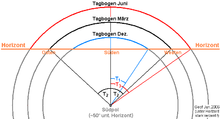Mid spring
In meteorology, mid-spring is the middle phase of spring , generally the period from mid- March to mid- April . According to other concepts, it specifically describes the full onset of the growing season in mid-April , such as the first spring in phenology .

The astronomical beginning of spring, the equinox of spring (the ascending equinox) occurs around March 21st (it can fall on the day before or after), the meteorological beginning of spring - for statistical reasons - March 1st, therefore is generally called the middle third of the meteorological spring, after the end of early spring , mid-spring or high spring (the latter often also means the end of spring, full spring ). The astronomical concept originally comes from the calculation of the Easter date , which is supposed to describe the maximum of the coming of spring: At the equinox, the daily extension of the light day is at its highest, within a week the day is extended by about half an hour (up to over 4 min / d), then the noticeable elongation quickly weakens again.
After singularity model of Hermann Flohn from the 1940s, one has the mid-spring (abbreviated Fm) as a typical Central European high-pressure situation around the 17th-22nd April specified. This situation, which was evident in the middle of the 20th century, is not very significant today.
The phenological calendar determines the actual occurrence of the beginning of vegetation in the year. In order to be able to measure this, indicator plants and / or characteristic animal behavior are determined , which can be used to statistically determine the progression from south to north ( isochronous model ), and how far the year has progressed on site compared to others. The first spring as a phenological season begins in Central Europe around the beginning of April, and much later at higher altitudes and latitudes . He expresses himself
- in the blossom of the wood anemone , the dandelion and the forsythia , later of blackthorn and maple , bird (wild) cherry . The leaves sprout and develop , initially hazel , horse chestnut and birch , about a week later also red beech , pedunculate oak , linden and maple, also especially in the mountainous region (wild) bilberry , sycamore maple and larch (needles).
- Agricultural pointers are green permanent grassland , the winter grain shoots (grows) , the rape pushes ears and forms buds . The sowing of late potatoes , fodder beets , corn and sunflowers also begins . Gooseberries , currants , sweet (cultivated) cherries , plums , apples and pears all bloom in fruit and wine growing . The grapevine is bleeding for the first time (sap flow at the interfaces).
The typical early spring bloomers are mostly "bumblebee flowers" because the bumblebees are a group of bees that can fly at much lower temperatures and can therefore start pollinating earlier . In mid-spring, the honeybee in particular flies .
In the Chinese farmer's calendar , which divides the year into 24 subdivisions, the first spring includes the time after the “awakening of the insects” ( 驚蟄 , jīngzhé - March 5th / 6th), the “mid-spring” ( 春分 , chūnfēn - after the equinox March 20/21), “Lichte Klarheit” (also translatable as “shine and shine”, 清明 , qīngmíng - April 4/5) and “Grain rain” ( 穀雨 , gǔyǔ - 20/21 April) . April). The weather rules, which apply above all to northern China , give reason to hope for a good harvest on these days without late frost and with light rain and warm winds. At Qingming , the dead are remembered, just as Europe is made into All Souls' Day in autumn. Guyu, as the name suggests, is the time of the grain sowing.
In Japan , mid-spring migrates northeast from late March in Kyūshū to around early May in Hokkaidō . Phenologically, this can be seen on the cherry blossom front, which is of enormous media importance in Japan because the cherry blossom festival ( Hanami , 花 花 'to look at blossoms') is one of the most important festivals.
literature
- Peter Bissolli, Christian-Dietrich Schoenwiese: Calendar -related weather phenomena in a new light. In: Naturwissenschaftliche Rundschau , 44 (1991) 5, ISSN 0028-1050 , pp. 169-175
Individual evidence
- ^ First spring , ZAMG: Phenology
- ^ First bloom , ZAMG : Phenology
- ↑ bud , ZAMG: phenology
- ↑ Leaf / needle development (larch) , ZAMG: Phenology
- ^ Budding / rising , ZAMG: Phenology
- ↑ Ear pushing / panicle pushing , ZAMG: Phenology
- ↑ Bud formation , ZAMG: Phenology
- ↑ Aussaat , ZAMG: Phenology
- ^ The new word: Winter solstice ( memento from January 25, 2012 in the Internet Archive ) . In: East Asia Institute, University of Applied Sciences Ludwigshafen am Rhein: Kaleidoskop , December 21, 2011
